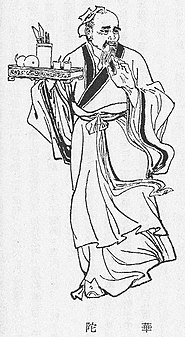Hua Tuo
| Hua Tuo | |
|---|---|

A Qing Dynasty portrait of Hua Tuo
|
|
| Physician | |
| Born | c. 140 |
| Died | c. 208 |
| Names | |
| Traditional Chinese | 華佗 |
| Simplified Chinese | 华佗 |
| Pinyin | Huà Tuó |
| Wade–Giles | Hua T'o |
| Courtesy name | Yuanhua (Chinese: 元化; pinyin: Yuánhuà; Wade–Giles: Yüan-hua) |
Hua Tuo (c. 140–208),courtesy name Yuanhua, was an ancient Chinese physician who lived in the late Eastern Han Dynasty. The historical texts Records of the Three Kingdoms and Book of the Later Han record Hua as the first person in China to use anaesthesia during surgery. He used a general anaesthetic combining wine with a herbal concoction called máfèisàn (麻沸散, lit. "cannabis boil powder"). Besides being respected for expertise in surgery and anaesthesia, Hua Tuo was famous for his abilities in acupuncture, moxibustion, herbal medicine, and medical Daoyin exercises. He developed the Wuqinxi (Wade–Giles: Wu-chin-hsi; 五禽戲; lit. "Exercise of the Five Animals") from studying movements of the tiger, deer, bear, ape, and crane.
The oldest extant biographies of Hua Tuo (tr. DeWoskin 1983:140-153 and Mair 1994:688-696) are found in the official Chinese histories for the Eastern Han Dynasty (25-220) and Three Kingdoms period (220-280). The 3rd-century Records of Three Kingdoms (Sanguozhi) and 5th-century Book of the Later Han (Houhanshu) record that Hua was from the district of Qiao (譙) in the state of Pei (沛, i.e., modern Bozhou, Anhui), and studied Chinese classics throughout Xu Province (covering parts of modern Jiangsu and Shandong). Hua refused employment offers from high-ranking officials (e.g., Chen Gui 陳圭) and chose to practise medicine.
...
Wikipedia
